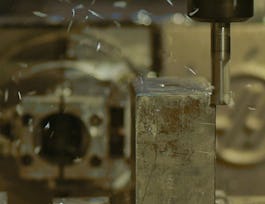CNC machines come in an almost endless array of configurations for various applications. So far, we have only talked about CNC Mills. More specifically vertical milling centers. In this course we turn our attention to the CNC Lathe. We identify the difference in a lathe’s coordinate system, tools, and how to create lathe specific toolpaths.


Creating Toolpaths for a CNC Lathe
This course is part of Autodesk CAD/CAM for Manufacturing Specialization
Taught in English
Some content may not be translated

Instructor: Autodesk
7,139 already enrolled
Included with 
Course
(138 reviews)
What you'll learn
Explore toolpaths for CNC Lathes.
Identify a lathe coordinate system.
Choose lathe specific tools.
Create turning toolpaths.
Skills you'll gain
Details to know

Add to your LinkedIn profile
2 quizzes
Course
(138 reviews)
See how employees at top companies are mastering in-demand skills

Build your subject-matter expertise
- Learn new concepts from industry experts
- Gain a foundational understanding of a subject or tool
- Develop job-relevant skills with hands-on projects
- Earn a shareable career certificate


Earn a career certificate
Add this credential to your LinkedIn profile, resume, or CV
Share it on social media and in your performance review

There are 4 modules in this course
In Week 1, we’ll learn how to set up a CNC Lathe coordinate system, stock, and begin cutting some basic geometry. The fundamental difference in how a lathe coordinate system is set and how the stock is held are critical to the success of turning toolpaths. Once we understand these concepts, we can begin exploring more complicated geometry.
What's included
9 videos6 readings1 quiz2 discussion prompts
In Week 2, we’ll dive in deeper to turning toolpath functionality by exploring internal and external grooving. With Fusion 360 we can identify and cut a single position groove as well as handle roughing and finishing multiple grooves in multiple orientations. So, let’s take a look at grooving toolpaths in Fusion 360.
What's included
5 videos3 readings1 discussion prompt
In Week 3, we’ll turn our attention to more finishing toolpaths to break edges and create threads. There are a few different ways to create threads on turned parts and we’ll start by looking at cutting external threads, tapping internal threads along the axis of revolution, as well as identifying live turning tools to drill and tap on a C-axis.
What's included
6 videos3 readings1 discussion prompt
In Week 4, we’ll learn more about various options that CNC Lathes can have. We’ll learn about parting to cut geometry away from the stock as well as some various options for stock transfer using multiple chucks. CNC lathes often can move another chuck in to grab the part, cut it away from stock, and then machine the back side. This advanced functionality is supported in Fusion 360 so let’s learn how to use it.
What's included
5 videos3 readings1 quiz1 peer review
Recommended if you're interested in Mechanical Engineering

Autodesk

Fractal Analytics

Google Cloud
Why people choose Coursera for their career




Learner reviews
Showing 3 of 138
138 reviews
- 5 stars
83.33%
- 4 stars
12.31%
- 3 stars
3.62%
- 2 stars
0.72%
- 1 star
0%

Open new doors with Coursera Plus
Unlimited access to 7,000+ world-class courses, hands-on projects, and job-ready certificate programs - all included in your subscription
Advance your career with an online degree
Earn a degree from world-class universities - 100% online
Join over 3,400 global companies that choose Coursera for Business
Upskill your employees to excel in the digital economy
Frequently asked questions
Yes! Autodesk also has Learning Pathways to start you on your learning journey, including certification prep courses and practice tests—so you feel confident when you take an Autodesk certification exam.
Visit this page to learn how to download Fusion 360 and to learn about the Autodesk Education license terms.
Professionals can purchase an annual or monthly commercial subscription to Fusion 360. For more information, visit the Fusion 360 subscribe page.
Fusion 360 is also available for free to all users as a 30-day trial.


